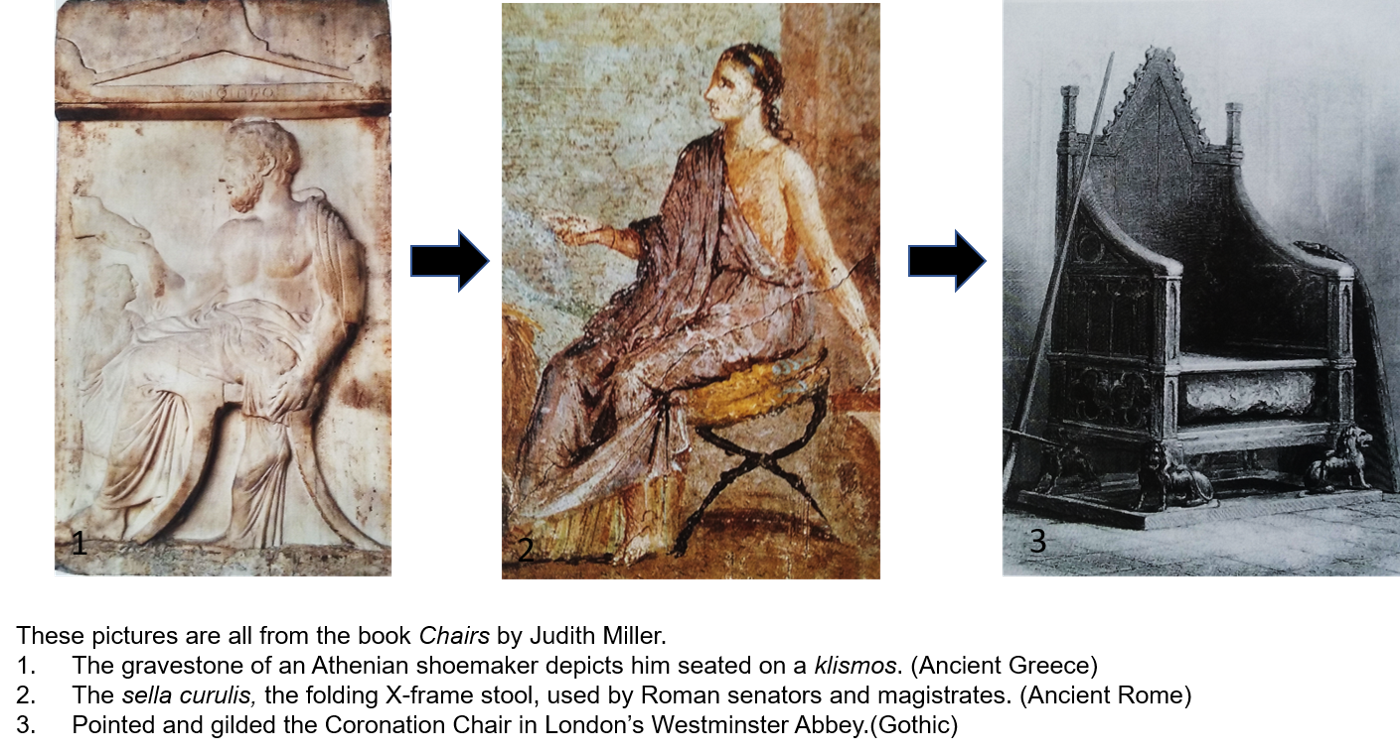Serenading the humble chair
One piece of furniture in the domestic household that has surely been designed and developed more than any other furniture is the CHAIR. Since ancient times where stools were the first type of chair, this piece of furniture has caught the imagination of designer and artist alike to create masterpieces.
While I was studying for my Interior Design diploma I had to do many assignments, all very diverse. One of them was to research the history of different periods including ancient Greece and Rome, the Gothic, Renaissance, Baroque and Rococo periods as well as Georgian and Victorian and the 20th Century. All from an Interior Design and Architectural perspective. This was a fabulous assignment because I learnt so much about the different time periods and how styles developed and changed. Here I also realised how this humble piece of furniture that has been around for centuries, has been developed and crafted by many designers, architects and artists, in practicality and style.
Ancient Egyptians and Greeks
It all started with the Ancient Egyptians who used a stool, either three or four-legged or with a type of X-frame. But if you were Pharaoh Tutankhamun you owned the most exquisite throne carved with beautiful pictures and decorated with different symbols. A wonderful book about chairs and which I used extensively in my assignment is the one by Judith Miller, titled Chairs. According to her the most common form of Greek seating was the stool with two basic models: the diphros with a flat rectangular seat raised on three or four legs and the diphros okladias, an improvement on the Egyptian folding X-frame stool.
Then there was the very innovative Greek chair – the klismos. A flat-fronted seat with four outwardly curved sabre-like legs. The Roman equivalent was the cathedra with a curved back and straight legs as well as the sella curulis, an X-frame stool highly decorated and only used by important people. Another popular form of seating for the Romans was the daybed (lectus); a prototype for variations of the chaise longue which came centuries later. With the Gothic period the chair changed again and the rounded arch became a pointed arch.

And at last everyone could take a seat and the chair was made accessible to all.
Baroque & Rococo, then Georgian & Victorian
Then there were the Baroque and Rococo periods. The Rococo architecture added more colour with cherubs making an appearance not only on churches and palaces, but also on tables and chairs. Rococo furniture is identifiable by its graceful, rounded silhouettes and shapely cabriole legs, ending in small scroll feet.
The Georgian and Victorian eras were next. And beautiful chairs appeared. The Early Georgian interior design and furnishings reflected the influence of the French style and was also the period of bronze, silk, satin and velvet. Legendary English designers of interiors and furniture: Adam, Chippendale, Hepplewhite and Sheraton, made their appearance during this time.

The cabriole leg remained but a ball-and-claw became the characteristic foot on early Georgian furniture. The Victorian era included overstuffed upholstery, layered draperies, fringed and tasselled carpets and textiles in different patterns of the revival styles.
20th Century
My personal favourite era is the 20th century design (Art Deco, Art Nouveau, Modernist) which saw a radical change in architecture and design.
Free-thinking designs started taking shape with more conscious architecture to result in functional living. Just think about Frank Lloyd Wright’s spiral ramp at the Guggenheim Museum in New York and Antoni Gaudi’s innovative self-indulgent and over the top buildings in Barcelona. Much more personal style.
Magnificent chairs appeared – some almost more artwork than comfortable seating. Mackintosh’s ladderback chair is one of his most famous pieces, recognisable by the horizontal slats. The basic shape was used in the Georgian period, but Mackintosh gave it a contemporary look.

The architect and furniture designer, Gerrit Thomas Rietveld (1888-1964), tried with the design of his Red/Blue chair to make the chair cheap to make and buy, which was a significant leap towards Modernism.
The Chaise Longue is one of Le Corbusier’s most famous designs. He also wanted to have his furniture designs mass-produced and more affordable, but in practice this didn’t work out.
Today you’ll pay a small fortune for a real Le Corbusier, Eileen Gray or Van der Rohe chair, in fact for any original created by any of these designers.
It seems this one piece of furniture, the chair, originally a sign of status, became a piece of furniture that changed the most during different eras, in style as well as how it was manufactured.

And whether you like them firm and straight, short and comfy, covered in bold or subtle colours or whatever your taste, you will always need a good comfortable chair.











Trackbacks & Pingbacks
[…] Not only was Le Corbusier an architect, but also famous for different furniture designs including chair designs like his Chaise Longue from the Art Nouveau era and more armchairs in the Art Deco style. I also mentioned him in a previous blog about the humble chair. […]
Leave a Reply
Want to join the discussion?Feel free to contribute!